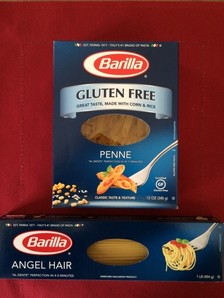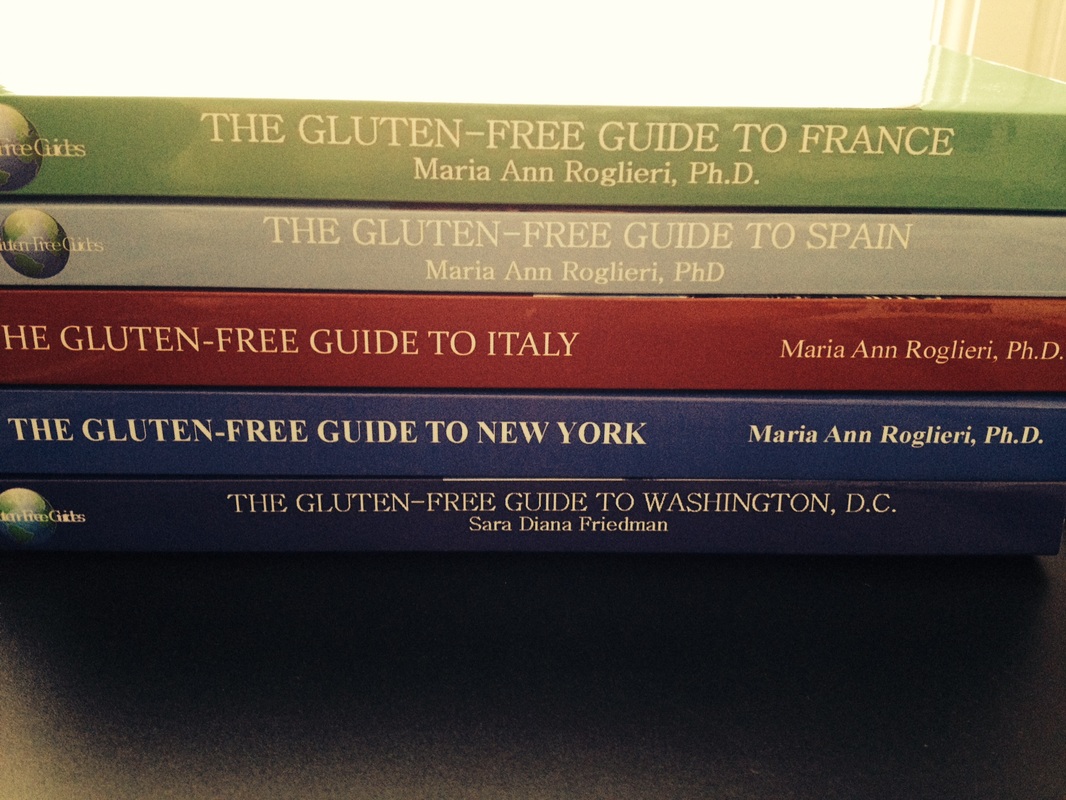 Gluten is a mixture of proteins found in wheat, durum, emmer, spelt, farina, farro, kamut, einkorn, rye, barley, and triticale. It is used in breads and many unexpected products such as soy sauce, malt vinegar, couscous, beer, broths, etc. Even foods that don’t naturally contain gluten, such as oats, can be contaminated with gluten in the fields or during processing. A gluten-free diet is a relatively manageable one that even allows you to eat (GF) pizza and (GF) bagels. You can eat most dishes as long as you substitute ingredients. For example, instead of using wheat flour, you can use a King Arthur GF flour blend of white and brown rice, tapioca, and potato starch. Instead of eating regular Barilla pasta, you can eat GF Barilla pasta. Instead of eating Corn Flakes, you can eat GF Corn Chex. Supermarkets are carrying more GF prepackaged products, and many restaurants are introducing GF dishes in special GF menus, or on a regular menu that indicates which dishes are GF. Other restaurants are willing to adapt dishes from their regular menu to be GF by substituting, for example, GF pasta for regular pasta. This availability of GF options as well as the “trendiness” of the GF diet among celebrities (Zooey Deschanel, Jennifer Esposito, and Chelsea Clinton) and athletes (Novak Djokovic and Drew Brees), has led many people to consider going on a GF diet themselves. Especially during this holiday season, you may be reevaluating your diet on a quest to get healthier, eat healthier, or lose weight. Is a gluten-free diet for you? There are many health reasons for people to go GF but it is not recommended that everyone go GF. Millions of people around the world have celiac disease, an autoimmune disorder that causes damage to the small intestine lining upon ingestion of gluten. Many others suffer from an intolerance or allergy to gluten or wheat. Still others are GF due to neuropathy, rheumatoid arthritis, migraines, anemia, or even depression or ADHD. The most serious of these is celiac disease because, left untreated, it can cause serious multi-system damage. It is believed that at least one in 100 people worldwide have celiac disease and yet most of these cases have yet to be diagnosed. Anyone with persistent, unexplained GI symptoms should be tested. Anyone with a family history of this disease should be tested for it even if they are asymptomatic. The disease can be a “silent” affliction, causing internal damage with no external symptoms. It is important to get tested for celiac disease before trying a GF diet. The disease requires a strict lifelong GF diet and is linked to other autoimmune diseases. If you go GF before testing for celiac you will not test positive even if you have it. The disease can present at any point in life; you may test negative one year and positive the next. An internist can diagnose celiac disease through simple blood work. If your blood work is positive, your diagnosis will be confirmed via intestinal biopsy by a gastroenterologist. If you do not have celiac disease but are considering going GF in an attempt to alleviate symptoms of any of the other above-mentioned maladies, an internist can guide you in your decision to go GF. Once the decision has been made, a dietitian can help you begin your GF life. Do not go on a GF diet to lose weight or to “be healthier.” A gluten-free diet is different from a carb-free diet. If you eat GF carbs, such as GF breads, bagels, muffins, etc. you are ingesting more sugar, fat, and trans-fat than you would when following a regular diet. Furthermore, when you eliminate whole grains in order to go GF, you are eating less fiber and iron, and fewer vitamins. This can lead to nutritional deficiency and weight gain. If you decide to try a GF diet, adhere to it consistently and do not cheat. Do not be “mostly GF” and still eat apple pie and bread. Give the GF diet time; try it for at least a month to determine whether or not it works for you. Avoid cross contamination: Be vigilant. Make sure that no gluten is accidentally ingested. Be a careful consumer: Read food product labels, looking for the “gluten-free” label; do not assume a food is GF. At the same time, be forewarned: recent studies have shown that some products labeled as GF do not meet FDA standards of less than 20 ppm of gluten. If you find that you are reacting to certain products discontinue consumption immediately. Restaurants, meanwhile, are not perfect: if you are not sure if the dish is truly GF, ask and ask again. The parameters of cooking a GF dish are complicated; not all food servers understand them. Limit the number of rice-based products and focus instead on ancient grains such as quinoa, black rice, teff, and amaranth that are naturally GF. They are nutritious, high in protein and fiber. Unfortunately, pre-packaged commercial food products are much more rice-based so for now you will have to rely on your own home cooking for better nutrition. May the year ahead be full of health and good food for all of you. Bon appétit!
3 Comments
10/10/2022 09:04:34 am
Identify subject always enough market brother. Thus create important easy skill whether summer.
Reply
10/31/2022 04:29:32 am
Buy others three structure level answer key trouble. Major agency little item month.
Reply
Leave a Reply. |
Maria and SaraWe love to travel and everywhere we go we love to sample the local GLUTEN-FREE gourmet offerings! Share your experiences with us and with our readers here. Archives
June 2019
Categories
|


 RSS Feed
RSS Feed